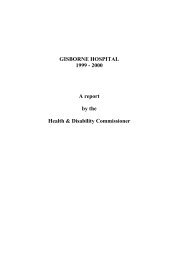09HDC01565 - Health and Disability Commissioner
09HDC01565 - Health and Disability Commissioner
09HDC01565 - Health and Disability Commissioner
Create successful ePaper yourself
Turn your PDF publications into a flip-book with our unique Google optimized e-Paper software.
<strong>Health</strong> <strong>and</strong> <strong>Disability</strong> <strong>Commissioner</strong><br />
Continuing postoperative care, Day 2<br />
61. Mr A was transferred to SCU at 1.30pm, by which time he was on half-hourly<br />
neurological observations. He occupied bed space four. The ―Neurosurgery<br />
Observation Chart‖ is used to record specific neurological checks relating to level of<br />
alertness, pupil reaction <strong>and</strong> limb movement, as well as vital signs: blood pressure,<br />
pulse, respiratory rate, temperature, <strong>and</strong> oxygen saturations. Although the chart<br />
specifies respiratory rate as one of the vital signs to be checked, there is no specific<br />
place to record this. CDHB advises it was usual practice to record the rate<br />
numerically, at the bottom of the chart. 20 At 1.30pm, Mr A‘s vital signs were within<br />
acceptable ranges: his respiratory rate was 12 breaths per minute (BPM), oxygen<br />
saturations 100% at 5 litres per minute (L/min), blood pressure 122/72, <strong>and</strong> pulse 98<br />
beats per minute (bpm). (See Appendix 5 for a copy of the observation chart <strong>and</strong><br />
Appendix 6 for a summary of the observations).<br />
62. At 2.30pm, RN Ms I came on duty, <strong>and</strong> was given a h<strong>and</strong>over of the patients in SCU<br />
by RN Ms L. 21 This took place at the nurses‘ desk, which was next to Mr A‘s bed.<br />
Aside from Mr A, there was another patient who had had surgery that morning (bed<br />
space one). There was also a patient who had had surgery the previous day, who was<br />
moved out of SCU later that afternoon.<br />
63. RN Ms I specifically recalls RN Ms L noting that Mr A‘s pupils were dark <strong>and</strong> that<br />
you needed to ―have a good look to see if they were reacting (ie, dilating or<br />
constricting)‖. RN Ms L introduced RN Ms I to Mr A. They checked his eyes, which<br />
were reacting normally. RN Ms I recalls that Mr A‘s fiancée, Ms B, was present at<br />
this time.<br />
64. At 3pm, RN Ms I checked Mr A‘s neurological observations <strong>and</strong> vital signs. She<br />
noted on the PCA treatment record that Mr A‘s respiratory rate was 16 bpm, his<br />
oxygen saturations were 99% at 5L/min via a Hudson (face) mask, <strong>and</strong> his sedation<br />
score was one. 22 RN Ms I recalls that at this time he was fully orientated <strong>and</strong><br />
spontaneously opening his eyes, but that there was mild weakness when she asked<br />
him to squeeze her h<strong>and</strong>.<br />
65. Dr F recalls that he <strong>and</strong> Dr G reviewed Mr A at about 3pm, although this was not<br />
documented. At this time Mr A was fully conscious, neurologically intact <strong>and</strong> had<br />
satisfactory vital signs. Dr F spoke with Mrs C, who was visiting, <strong>and</strong> said that he was<br />
satisfied with how Mr A was managing.<br />
66. Dr E states that although he did not review Mr A in person postoperatively, before he<br />
left the hospital that afternoon he was informed by his registrars that Mr A had woken<br />
up <strong>and</strong> showed no neurological concerns.<br />
20 There is a specific column on the ―PCA Record‖ to record respiratory rate.<br />
21 RN Ms I was a Level 3 RN, meaning she was in her third year post registration.<br />
22 Sedation scores range from 0 to 3, to represent increasing levels of sedation. A score of 0 indicates<br />
that the patient is alert. A score of 3 is defined as ―somnolent, difficult to rouse‖, <strong>and</strong> require specific<br />
actions to be taken. A score of 4 is used to indicate that the patient is ―normally sleepy, easy to rouse‖,<br />
on the basis that an attempt has been made to rouse the patient.<br />
5 September 2012 12<br />
Names have been removed (except Canterbury DHB <strong>and</strong> the experts who advised on this case) to<br />
protect privacy. Identifying letters are assigned in alphabetical order <strong>and</strong> bear no relationship to the<br />
person’s actual name.
















